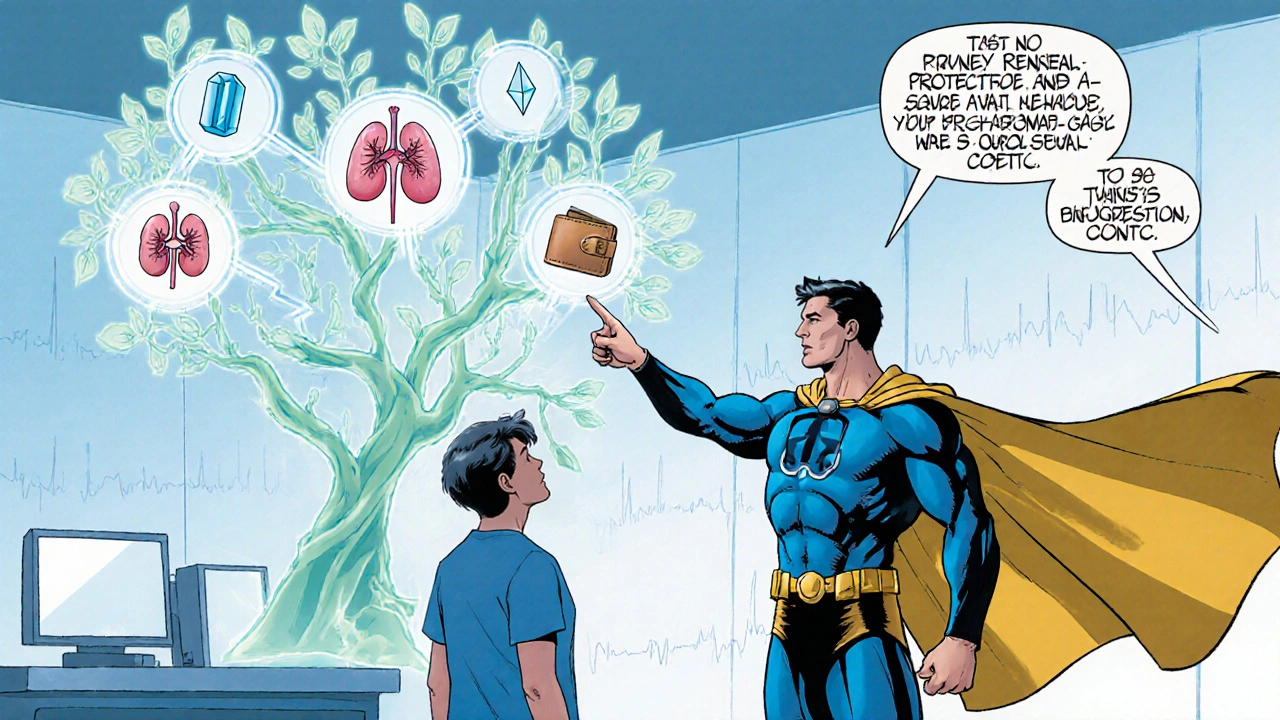Blood Pressure Medication Dose Converter
Results will appear here
When you’re prescribed Telmisartan for high blood pressure, one of the first thoughts is often: “Are there other pills that work just as well, maybe with fewer side effects?” This article breaks down Micardis, its place in the ARB family, and the most common alternatives, so you can see the trade‑offs in plain English.
What Is Micardis (Telmisartan)?
Micardis is the brand name for telmisartan, an angiotensinII receptor blocker (ARB) that relaxes blood vessels, lowering systolic and diastolic pressure. It was approved by the FDA in 1999 and is now available as a generic. The typical daily dose for adults is 40mg or 80mg, taken with or without food. Because it has a long half‑life (about 24hours), most people need just one tablet a day.
How Telmisartan Works
Telmisartan blocks the binding of angiotensinII to the AT1 receptor. Think of angiotensinII as a “vasoconstrictor” hormone that tells your arteries to tighten. When the signal is blocked, the vessels stay relaxed, blood flows more easily, and the heart doesn’t have to pump as hard.
Key Benefits and Common Side Effects
- Benefits: Once‑daily dosing, effective in both black and white patients, proven kidney‑protective effects in diabetics.
- Common side effects: Dizziness, upper‑respiratory infections, fatigue. Serious but rare issues include hyperkalemia and angio‑edema.
When Do Doctors Choose Micardis?
Doctors often pick Micardis for patients who:
- Need a long‑acting ARB without a large loading dose.
- Have a history of cough with ACE inhibitors (ARBs avoid that side effect).
- Are at risk for diabetic nephropathy - telmisartan showed slowed progression in trials.

Choosing an Alternative: What to Compare
Before you hop to a different pill, ask yourself these questions:
- Mechanism: All ARBs share the same basic block, but some have extra benefits (e.g., Losartan has a metabolite that mildly lowers uric acid).
- Dosing frequency: Does the alternative require once‑daily or twice‑daily?
- Cost & insurance coverage: Generic versions can be dramatically cheaper.
- Side‑effect profile: Does the drug cause more cough, swelling, or electrolyte issues?
- Kidney & heart protection data: Some ARBs have extra trial evidence for heart failure.
Top Alternatives to Micardis
| Drug (Brand) | Generic | Typical Dose | Key Advantage | Main Drawback |
|---|---|---|---|---|
| Micardis | Telmisartan | 40-80mg once daily | Long half‑life, strong renal protection | Higher price if brand‑only |
| Cozaar | Losartan | 50mg once daily or 25mg twice daily | Effective for gout patients, lower cost | Shorter half‑life, may need twice‑daily dosing |
| Diovan | Valsartan | 80-160mg once daily | Strong data in heart‑failure patients | May raise potassium more than other ARBs |
| Benicar | Olmesartan | 20-40mg once daily | Very potent blood‑pressure reduction | Rare cases of severe sprue‑like enteropathy |
| Avapro | Irbesartan | 150-300mg once daily | Good for diabetic kidney disease | More expensive generic |
| Prinivil | Lisinopril (ACE inhibitor) | 10-40mg once daily | Proven mortality benefit in post‑MI patients | Cough in up to 10% of users |
Deep Dive into Each Alternative
Losartan (Cozaar)
Losartan was the first ARB on the market, approved in 1995. Its active metabolite, EXP‑3174, has a half‑life of about 6‑9hours, so some clinicians split the dose. It’s often chosen for patients who also need uric‑acid lowering, like gout sufferers.
Valsartan (Diovan)
Valsartan shines in heart‑failure trials (the Valsartan Heart Failure Trial). It’s also a favorite for patients with left‑ventricular dysfunction. Watch potassium levels; valsartan can increase them more than telmisartan.
Olmesartan (Benicar)
Olmesartan is potent; a 20mg dose can bring blood pressure down by 15mmHg systolic on average. However, a rare but serious side effect-sprue‑like enteropathy-led the FDA to add a warning in 2013.
Irbesartan (Avapro)
Irbesartan has strong data for slowing diabetic nephropathy progression. It’s often prescribed to patients with both hypertension and early‑stage kidney disease. The cost is higher because the generic entered the market later.
Lisinopril (Prinivil) - The Classic ACE Inhibitor
Though not an ARB, lisinopril is a key alternative for those who can tolerate the cough. It reduces mortality after heart attacks and is inexpensive as a generic. The main downside is the dry‑cough side effect and a slightly higher risk of angio‑edema.

How to Decide Which Drug Fits You Best
Here’s a quick decision tree you can run with your doctor:
- Do you have chronic kidney disease? If yes, Micardis or Irbesartan have the best evidence.
- Do you experience cough with ACE inhibitors? Switch to any ARB-Micardis, Losartan, etc.
- Is cost a major concern? Generic Losartan or Valsartan may be cheaper than brand‑only Micardis.
- Any history of gout? Losartan may help lower uric acid.
- Any gastrointestinal sensitivities? Avoid Olmesartan due to rare enteropathy.
Always discuss labs (especially potassium and creatinine) before changing meds.
Practical Tips for Switching or Starting a New Blood‑Pressure Pill
- Never stop a medication abruptly. Tapering is usually not required for ARBs, but coordinate with your prescriber.
- Schedule a follow‑up BP check within 2‑4 weeks of any change.
- Monitor labs (K+, creatinine) at baseline and after the first month.
- Keep a side‑effect diary. Note dizziness, swelling, or persistent cough.
- Ask about drug interactions. NSAIDs, potassium‑sparing diuretics, and certain antibiotics can raise potassium.
Frequently Asked Questions
Can I take Micardis with a ACE inhibitor?
Usually not recommended. Combining an ARB with an ACE inhibitor increases the risk of high potassium and kidney injury. Your doctor may only do it in very specific heart‑failure cases and will monitor labs closely.
How long does it take for Telmisartan to lower blood pressure?
Because of its long half‑life, you can see a modest drop within 2‑3 days, but the full effect often appears after 2‑4 weeks of consistent dosing.
Is Telmisartan safe during pregnancy?
No. ARBs, including telmisartan, are classified as pregnancy‑category D. They can cause fetal kidney problems and should be stopped as soon as pregnancy is confirmed.
Can I switch from Micardis to Losartan one‑for‑one?
The doses aren’t equivalent. A typical conversion is 40mg Micardis ≈ 50mg Losartan, but your doctor will consider your blood‑pressure targets and may adjust the dose.
What should I do if I experience a persistent cough on lisinopril?
Talk to your provider. They’ll likely switch you to an ARB like Micardis or Losartan, which rarely cause cough.
Choosing the right antihypertensive is a balance of effectiveness, side‑effects, cost, and personal health history. Micardis remains a solid first‑line ARB, but alternatives such as Losartan, Valsartan, Olmesartan, Irbesartan, and even ACE inhibitors like Lisinopril give you and your doctor flexibility. Keep the conversation open, track your numbers, and you’ll land on the pill that keeps your heart and kidneys happy.



Yassin Hammachi
Thinking about blood pressure meds often feels like weighing options on a moral scale – efficacy, side‑effects, and cost all have their own weight. Telmisartan’s long half‑life is a real convenience, especially for folks who miss doses. The kidney‑protective data gives it a compassionate edge for diabetics. If you’re looking for a once‑daily pill that doesn’t trigger the typical ACE cough, Micardis fits nicely. Still, checking insurance coverage early can spare surprise bills. Ultimately, it’s about finding a balance that respects your health and your wallet.